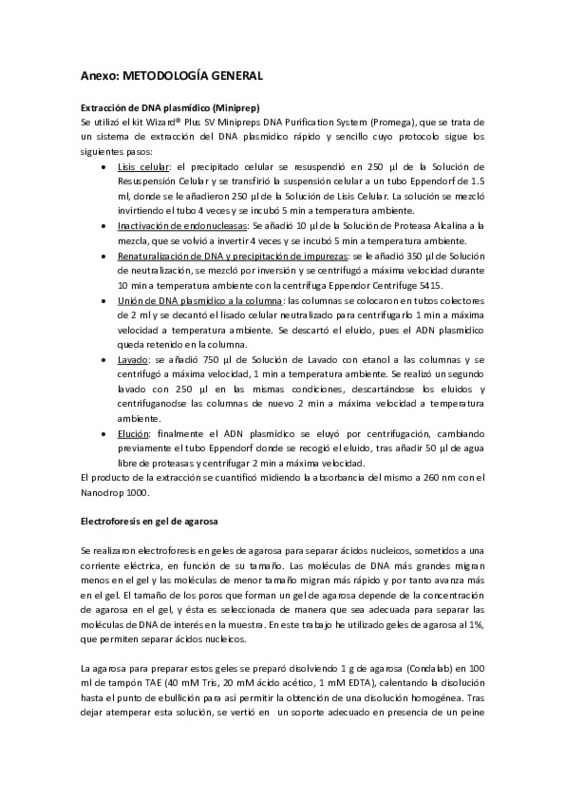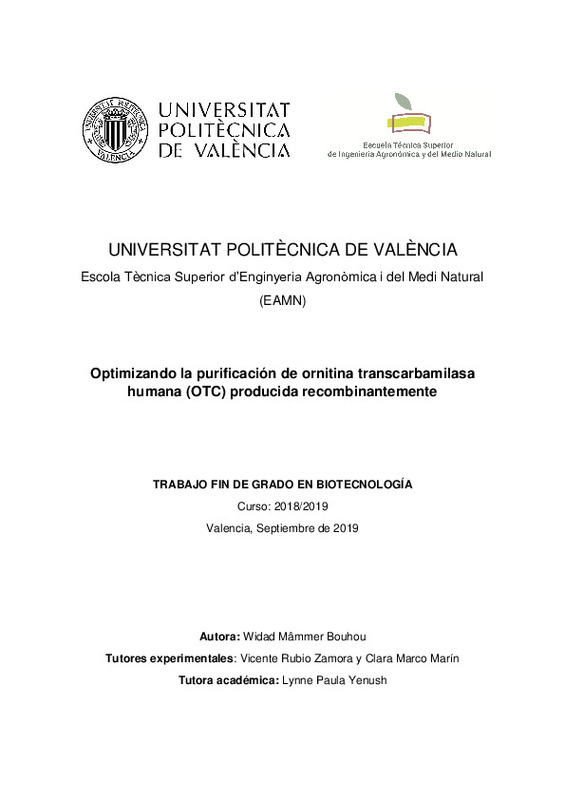JavaScript is disabled for your browser. Some features of this site may not work without it.
Buscar en RiuNet
Listar
Mi cuenta
Estadísticas
Ayuda RiuNet
Admin. UPV
Optimizando la purificación de ornitina transcarbamilasa humana (OTC) producida recombinantemente
Mostrar el registro sencillo del ítem
Ficheros en el ítem
| dc.contributor.advisor | Rubio Zamora, Vicente
|
es_ES |
| dc.contributor.advisor | Marco Marín, Clara
|
es_ES |
| dc.contributor.advisor | Yenush, Lynne Paula
|
es_ES |
| dc.contributor.author | Mammer Bouhou, Widad
|
es_ES |
| dc.date.accessioned | 2019-10-08T11:02:48Z | |
| dc.date.available | 2019-10-08T11:02:48Z | |
| dc.date.created | 2019-09-23 | |
| dc.date.issued | 2019-10-08 | es_ES |
| dc.identifier.uri | http://hdl.handle.net/10251/127721 | |
| dc.description.abstract | [ES] La ornitina transcarbamilasa (OTC) es un enzima mitocondrial que cataliza el segundo paso del ciclo de la urea, la reacción entre carbamil fosfato y ornitina para formar citrulina y fosfato. Esta ruta metabólica convierte el amonio derivado del catabolismo proteico, que es altamente tóxico, en urea, molécula inocua que se elimina en la orina. [1] Mutaciones en el gen para OTC (Xp21.1) causan la deficiencia de OTC (OTCD), el error más frecuente del ciclo de la urea. Los síntomas de OTCD se deben a la toxicidad del amonio acumulado y son variables dependiendo de la mutación presente en hemicigosis en los pacientes. Su forma más severa, neonatal temprana, generalmente afecta a varones, manifestándose con irritabilidad, falta de energía y apetito, letargia, convulsiones y coma. Aunque tratable, la OTCD puede conducir a la muerte o al retraso del desarrollo, discapacidad intelectual y daño hepático. Con menos frecuencia, la OTCD se manifiesta tardíamente, generalmente en presentaciones menos graves, tanto en hombres como en mujeres. Sus síntomas pueden incluir episodios de delirio, nivel reducido de conciencia, dolores de cabeza, vómitos, convulsiones y pérdidas prolongadas de conciencia en situaciones de estrés catabólico (parto, accidentes, cirugía, etc). [1] Para entender el funcionamiento de la OTC, establecer correlaciones genotipo-fenotipo y determinar el impacto de las mutaciones descritas (la mayoría de ellas sustituciones de aminoácido [2]) sobre la estabilidad, la actividad y los parámetros cinéticos, es clave producir OTC humana recombinante. En el laboratorio esto se consigue utilizando un sistema de expresión en E. coli [3] en el que la forma madura de OTC humana (es decir, sin secuencia señal de internalización mitocondrial) se coexpresa en presencia de chaperonas sobreexpresadas que favorecen su correcto plegamiento [3]. El procedimiento de purificación empleado (modificado de [4]) es laborioso, implica cinco etapas de purificación, incluyendo precipitación con sulfato amónico, diálisis y cromatografia de intercambio iónico. La purificación por afinidad utilizando como ligando N-5-fosfonacetil-L-ornitina (PALO) [5] es una alternativa muy útil, pero requiere sintetizar PALO, pues este compuesto no está disponible comercialmente [5]. Por ello planteamos como objetivo de este trabajo optimizar la producción de OTC humana mediante la introducción de una etiqueta de polihistidinas que facilite la purificación por cromatografía de afinidad metálica con resina comercial. He utilizado dos vectores de expresión y sistemas de clonación independientes de ligasa: pLIC-SGC1 (ver en Addgene, https://www.addgene.org/39187/) para añadir una etiqueta de polihistidinas en el extremo N-terminal; y popinE/In-fusion [6], para añadir la etiqueta en el extremo C-terminal. Estas dos alternativas se plantearon por el hecho de desconocer el impacto que la extensión de polihistidinas pudiera tener sobre el plegamiento o la actividad enzimática. A partir de estas dos construcciones hemos producido las formas correspondientes de OTC humana recombinante, que hemos purificado utilizando columnas de níquel y un sistema de cromatografía automatizada rápida de media presión (FLPC). Habiendo comprobado que ambas formas con etiquetas de polihistidinas presentan actividad catalítica, el objetivo es ahora comparar estas actividades así como los parámetros cinéticos y la estabilidad enzimática con los del enzima carente de etiquetas que se venía produciendo previamente en el laboratorio, con el objetivo último de establecer un protocolo alternativo de obtención de OTC humana, que permita abordar el estudio facil de nuevos mutantes descritos en pacientes con OTCD tras su producción y purificación rápida. [1]. Häberle J et al. Suggested guidelines for the diagnosis and management of urea cycle disord | es_ES |
| dc.description.abstract | [EN] Ornithine transcarbamylase (OTC) is a mitochondrial enzyme that catalyzes the second step of the urea cycle, the reaction between carbamyl phosphate and ornithine to form citrulline and phosphate. This metabolic pathway converts ammonium derived from protein catabolism, which is highly toxic, into urea, an innocuous molecule that is eliminated in the urine. [1] Mutations in the gene for OTC (Xp21.1) cause OTC deficiency (OTCD), the most frequent error of the urea cycle. The symptoms of OTCD are due to the toxicity of the accumulated ammonium and are variable depending on the mutation present in hemizigosis in patients. It s more severe, early neonatal form usually affects males, festering with irritability, lack of energy and appetite, lethargy, seizures and coma. Although treatable, OTCD can lead to death or developmental delay, intellectual disability and liver damage. Less frequently, OTCD manifests itself late, usually in less severe presentations, in both men and women. Its symptoms may include episodes of delirium, reduced level of consciousness, headaches, vomiting, seizures and prolonged loss of consciousness in situations of catabolic stress (childbirth, accidents, surgery, etc). [1] To understand the functioning of OTC, establish genotype-phenotype correlations and determine the impact of the described mutations (most of them amino acid substitutions [2]) on stability, activity and kinetic parameters, it is key to produce recombinant human OTC . In the laboratory this is achieved using an expression system in E. coli [3] in which the mature form of human OTC (ie, without a mitochondrial internalization signal sequence) is co-expressed in the presence of overexpressed chaperones that favor its correct folding [3]. The purification procedure employed (modified from [4]) is laborious, involving five purification steps, including ammonium sulfate precipitation, dialysis and ion exchange chromatography. Affinity purification using as ligand N-5-phosphonacetyl-L-ornithine (PALO) [5] is a very useful alternative, but requires synthesizing PALO, as this compound is not commercially available [5]. Therefore, we propose as the goal of this work to optimize the production of human OTC by introducing a polyhistidine label that facilitates the purification by metal affinity chromatography with commercial resin. I have used two expression vectors and ligase-independent cloning systems: pLIC-SGC1 (see Addgene, https://www.addgene.org/39187/) to add a polyhistidine tag at the N-terminus; and popinE / In-fusion [6], to add the label at the C-terminal end. These two alternatives were raised by the fact of not knowing the impact that the extension of polyhistidines could have on the folding or the enzymatic activity. From these two constructs we have produced the corresponding forms of recombinant human OTC, which we have purified using nickel columns and a rapid medium pressure automated chromatography system (FLPC). Having verified that both forms with polyhistidine labels present catalytic activity, the objective is now to compare these activities as well as the kinetic parameters and the enzymatic stability with those of the enzyme lacking labels that had previously been produced in the laboratory, with the ultimate goal of establish an alternative protocol for obtaining human OTC, which allows easy study of new mutants described in patients with OTCD after its production and rapid purification. [1]. Häberle J et al. Suggested guidelines for the diagnosis and management of urea cycle disorders: first revision. J Inherit Metab Dis. 2019. doi10.1002/jimd.12100. [2]. Arranz JA, Riudor E, Marco-Marín C, Rubio V. Estimation of the total number of disease-causing mutations in ornithine transcarbamylase (OTC) deficiency. Value of the OTC structure in predicting a mutation pathogenic potential. J Inherit Metab Dis. 2007;30:217-26. [3]. Morizono H et al. Expression, p | es_ES |
| dc.format.extent | 52 | es_ES |
| dc.language | Español | es_ES |
| dc.publisher | Universitat Politècnica de València | es_ES |
| dc.rights | Reserva de todos los derechos | es_ES |
| dc.subject | OTC purificación | es_ES |
| dc.subject | OTC etiquetada | es_ES |
| dc.subject | OTC deficiencia | es_ES |
| dc.subject | Enfermedades del ciclo de la urea | es_ES |
| dc.subject | UCDs | es_ES |
| dc.subject | OTC production | es_ES |
| dc.subject | OTC purificaction | es_ES |
| dc.subject | OTC tag | es_ES |
| dc.subject | OTC deficiency | es_ES |
| dc.subject | Urea cycle disorders | es_ES |
| dc.subject.classification | BIOQUIMICA Y BIOLOGIA MOLECULAR | es_ES |
| dc.subject.other | Grado en Biotecnología-Grau en Biotecnologia | es_ES |
| dc.title | Optimizando la purificación de ornitina transcarbamilasa humana (OTC) producida recombinantemente | es_ES |
| dc.type | Proyecto/Trabajo fin de carrera/grado | es_ES |
| dc.rights.accessRights | Abierto | es_ES |
| dc.contributor.affiliation | Universitat Politècnica de València. Departamento de Biotecnología - Departament de Biotecnologia | es_ES |
| dc.contributor.affiliation | Universitat Politècnica de València. Escuela Técnica Superior de Ingeniería Agronómica y del Medio Natural - Escola Tècnica Superior d'Enginyeria Agronòmica i del Medi Natural | es_ES |
| dc.description.bibliographicCitation | Mammer Bouhou, W. (2019). Optimizando la purificación de ornitina transcarbamilasa humana (OTC) producida recombinantemente. http://hdl.handle.net/10251/127721 | es_ES |
| dc.description.accrualMethod | TFGM | es_ES |
| dc.relation.pasarela | TFGM\111821 | es_ES |
Este ítem aparece en la(s) siguiente(s) colección(ones)
-
ETSIAMN - Trabajos académicos [3541]
Escuela Técnica Superior de Ingeniería Agronómica y del Medio Natural







